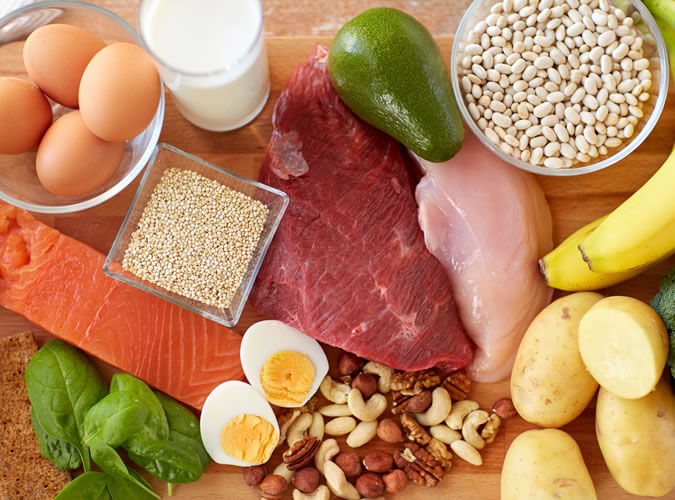Fitness is on what you might call a bulking phase. As of May 2017, there were almost 10m Brits sweating away at the gym every month, according to market aggregator Leisure DB, an increase of 5.1 per cent on the previous year. The same report also values the UK gym industry at a staggering £4.7 billion. In the US, over 55 million people had a gym membership in 2015, with figures no doubt continuing to climb in the years since the data was collected.
Whichever way you look at it, fitness is big business. Bolstered by the trend for wellness, calisthenics, yoga, CrossFit, and a generally more holistic outlook, more and more men are joining the local sweat box. But, for some – dare we say, the majority – deep down, a single desire remains: the desire to bulk up, gain weight, build muscle, and fill out those T-shirts for a summer body.
Of course, for some, how to gain weight is simple: you eat a lot and lift heavy weights. For others, it can be more difficult. Hitting the gym five days a week and seeing no gains? Knocking back 4,000 calories a day, to no avail? Tried every protein powder on the shelf but nothing’s working? A number of factors could be at play (try cutting out the cardio, for example – you don’t want to burn off muscle mass if you’re trying to grow). However, Luke Grahame, muscle-bound trainer at London’s high-end private gym Roar Fitness, has one particular bugbear:
“Show me a skinny guy who can’t put on weight and I’ll show you a skinny guy who doesn’t eat enough,” he says. “Whilst genetics, exceptionally high metabolisms, and extreme ectomorphic (skinny) body types do exist and have a part to play, the number one reason that some people struggle to gain weight is simply that they don’t eat enough. It’s a common trait of so-called ‘hardgainers’ to grossly overestimate what they eat, and inversely underestimate how much food is required to build genuine muscle.”

Let’s unpack that. First of all, ‘ectomorph’ refers to a person with a naturally svelte physique, like Russell Brand or Jarvis Cocker. The other body types to be aware of are ‘endomorph’ and ‘mesomorph’. The former describes a pear-shaped body with a tendency to store fat. Think: Jack Black. The latter describes a muscular and well built body with a fast metabolism and muscle cells that respond quickly and efficiently to exercise. Think: Zac Efron. Knowing which body type best describes you (and being honest about it) is a good place to start.
A ‘hardgainer’ meanwhile, is a person who practises bodybuilding techniques, but finds it difficult to gain weight. Naturally, their opposite number is the ‘easygainer’. And if the latter describes you, you’re reading the wrong article.
Of course, any attempt to get fitter is great. According to NHS figures, in 2016, 26% of UK adults were considered obese. Meanwhile, in the US, obesity rates have reached 35% in five states, with the lowest instance at 22.3% in Colorado. And we needn’t tell you that carrying all this extra heft around can have significant and fatal consequences now and in later life.

Building strength and (although not necessarily) muscle mass, is a side-effect of any exercise, and the focus should always be on a balanced approach to working out, and your own functionality. What’s the use of having arms the size of fire hydrants if you can’t lift them over your head?
Likewise, it’s not exactly healthy seeking self-worth in how your body looks. Mind, the mental health charity, classes body dysmorphia as a mental health disorder, which can lead to a whole host of secondary problems from depression to alcoholism. Similarly, relying on steroids to add muscle mass may seem like a short cut, but alongside immediate side effects like acne and aggression, some steroids have also been show to lead to heart attack, stroke, and death.
To help you safely navigate the pitfalls of bulking up, here’s how to gain weight naturally, and in a way that won’t compromise your health or happiness.
In The Kitchen
You’ve worked out which body type you have, have a rough idea of how much weight you want to gain, and how many calories you take in each day. Now what? Most people think it’s a good idea to work out your resting metabolic rate (or RMR) – how many calories you burn when you’re resting in front of Netflix. Grahame disagrees:
“Forget about calculating RMR (it’s likely inaccurate anyway). Track what you eat for a week by logging in a calorie tracking app (you know the one…) and take the average. This is what currently maintains your bodyweight, and therefore it’s not enough. Add another 500 kcal on top of your daily intake. If you gain weight, keep eating the same amount of calories. If you don’t gain weight after three weeks add another 250 – 500kcal to your daily intake. Repeat until the gains start to come.”

This might sound a rather slap-dash approach, but remember, the aim here is to gain weight, not to carve out a six-pack. If that is your aim, you can reduce calories safely and gradually once you’ve attained the weight you’re looking for. As such, there’s no point splitting hairs at this point about specific macros.
“When looking to gain weight, don’t overanalyse finely detailed macronutrient splits. You need proteins, carbs, and fats, and you need lots of them. Set protein at a minimum 2g per kg bodyweight. For example, a skinny 70kg male would need 140g protein minimum. Split the rest of the calories between carbs and fats – the ratio is unimportant at this point, just make sure there’s lots of them,” says Luke.
“In terms of meal frequency, the most important factor is getting all the necessary food/calories in by the end of the day. With this is in mind, and factoring for the hardgainers’ notorious lack of appetite, it’s worth noting that five meals of 600kcal average a day are likely easier to stomach than three meals of 1000 kcal average a day (based on a daily caloric intake of 3000 kcal).”

So what should you be piling on your plate? Fad diets like Atkins advise sticking to a low carb diet. This is the antithesis of a bulking diet, as carbs replenish your muscles energy stores, helping you work out again the next day, and giving you a fuller, more rounded look. The GOMAD diet, however, suggests you drink a gallon of milk per day. Which, while packed with calcium and protein, really doesn’t make much sense. Not only that, if you’re mixing your protein shakes with milk, you’ll take on an additional 400 calories per drink. And while you’re trying to up your calories, 400 extra calories that you aren’t keeping track of will quickly contribute to your belly – the wrong kind of bulking. Stick to water and some energy sups instead.
According to Grahame, if you stock the following items in your kitchen and consume them as per the ratios outlined above, you won’t go far wrong (note the lack of chocolate and ice cream – we aren’t interested in the ‘dirty bulk’. Sorry):
- 15% fat steak mince
- Chicken thighs
- Oats
- Rice
- Eggs
- Green vegetables
Pain & Gain
As almost any gym-goer will know, gaining weight isn’t as simple as rocking up to the local gym and going hell for leather with the dumbbell exercises. Nor is it about spending every session working your chest. Balance is key, and compound moves that bring in all areas of the body will help you build size quickly. As such, the bench press, squat, and deadlift are essential to your arsenal.
Whatever your exercise plan, time under tension is important. In other words, slowly lowering each weight before quickly pushing/pulling it up again. Because your muscles have to struggle under strain for longer, they’ll be forced to adapt to handling heavy weights. When it comes to weights, start with a manageable one, and aim to up the weight each week.
“Rather than splitting the body parts up into arm days or shoulder days, my advice to skinny guys looking to get bigger is to train the whole body every session – hard, heavy, and frequently – using big compound movements. Blunt trauma rather than fine needlework,” advises Grahame.
Two to three sets of 6-12 controlled reps is better for muscle growth than pumping out 15 quick and messy reps. Sure, you could do this, but it’d only lead to imbalances, which will immobilise your progress further down the line. Train everything slowly and evenly, and your triceps and biceps, glutes and thighs will work in tandem, as they were designed to do.
With that in mind, here’s Grahame’s beginner workout. Complete this circuit three times per week with four sets of 9-11 reps per exercise. Perform it at a 3.0.1.0 tempo (three seconds decline, one second push). Most importantly, use your rest days for growth and repair, not cardio.
The Full-Body Weight Gain Workout
1. BARBELL FRONT SQUAT rest 90 seconds
2. PULL UPS rest 90 seconds
3. BARBELL DEADLIFT rest 90 seconds
4. INCLINE DUMBBELL CHEST PRESS rest 2-3 min
Know How To Grow
Nutrition and exercise are the most important factors for growth but they aren’t the only things you need to consider. If you’re still having difficulty gaining weight, lifestyle factors could well be to blame.
Illness
Naturally, being under the weather means you may not feel like pumping iron. Which is fine. The problem is trying to push through instead of recovering. Do this and you could cause inflammation and torn muscles or cartilage damage which can take a lot longer to heal and derail your plans.
Sleep
Conor McGregor might train at all hours, but it’s unlikely that you have quite as much time to devote to training as him. Stick to regular hours and get plenty of sleep to allow recovery and growth to happen. Blue light from TV, laptop and phone screens can stimulate the brain at bed time, preventing you from dropping off. As can exercising too close to bed time. Opt for an earlier session and a no-screens in the bedroom rule to ensure optimum recovery and weight gain.

Cardio
You may naturally feel like a runner or cyclist. But maintaining your cardio addiction while trying to bulk up won’t work. While cardio is great for cutting fat, it’ll also toast the calories you ned to fire muscle growth, and sap the energy required to lift heavy, muscle-growing weights. So put your running shoes away for now – or at least cut back to one session per week.
Supplements
If you favour energy drinks and bars to help give you a boost in the gym, fine. But watch out for sugar and stimulant content. An over-reliance can lead to you staying awake when you should be resting, and even over-training to injury. Some trainers swear by multivitamins, amino acids and creatine. Others skip the supps entirely. Experiment, and see what works for you.

Stress
We’re all stressed in one way or another, but try to deal with it. Too much of the stress hormone cortisol can interfere with testosterone production and slow down muscle growth, reducing your gains. Plus, too much cortisol can even lead to the breakdown of the muscle you already have. A good way to chill out is to cut out the coffee (or at least replace it with tea), as caffeine places the body in stress mode, starting the process of cortisol release. Plus, it’s difficult to lift weights with the jitters.
Rest
Yes, you want to bulk up as quickly as possible. And yes, it’s addictive once you start. But have a day off every now and then and you’ll see benefits more quickly. Not only will overdoing it likely lead to injury, but none stop training will over strain your muscles without giving them time to grow and recover, which is exactly the point. So, have a day off in front of the TV once or twice a week. Forget about training for the time being and don’t beat yourself up if progress seems slow. Having a bigger chest isn’t the most important thing in the world, after all.
